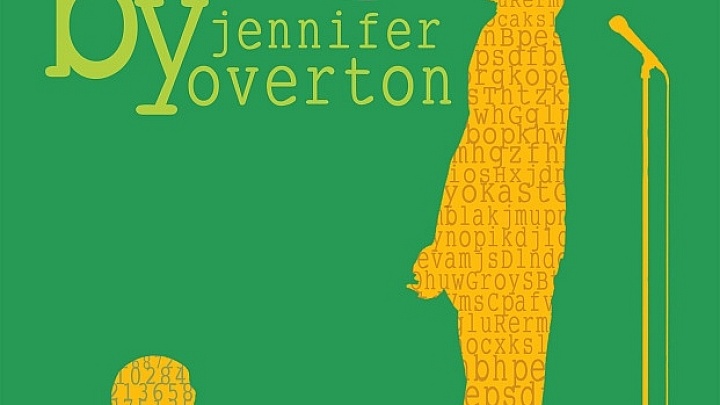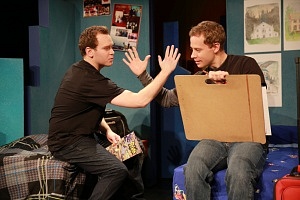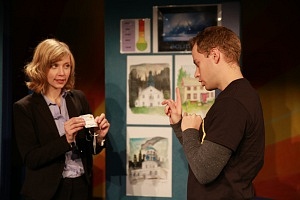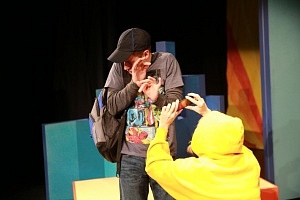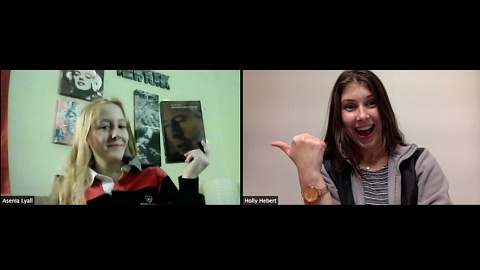It’s been a few weeks since the final performance of Brock University Department of Dramatic Arts’ Fall Mainstage, Scenes from an Execution. Closing off their...
By DART Critics
February 26, 2016
The cast of Spelling 2-5-5 has embarked on a fun and educational journey travelling from school to school performing for grades 4-8 across the Niagara region. Spelling 2-5-5 promotes a better understanding of children who are diagnosed with autism spectrum disorder and the issues they face both at home and school. This is an excellent show for elementary students to watch, since not only does it deliver a fantastic message but it also involves themes such as relationships, family struggles, bullying, the importance of being inclusive and displaying empathy — and many more. As embedded critics we have had the privilege of following some of the cast’s journey through the schools. Come along as we take you through the city of St. Catharines on a journey of your own from school to school. Each school is a new experience and a new adventure for the embedders and the cast! First stop — Carleton Public School.
Carleton Public School Visit: Tuesday, February 2
Olivia De Sousa writes: Navigating my way through the city of St Catharines, I eventually landed on the doorstep of a small, quirky elementary school. I made my way down to the gymnasium and joined the cast of Spelling 2-5-5 as they were warming up for what was only their second school performance.
As I sat in the gymnasium waiting for the children to arrive, I thought back to the performance I’d seen at the Robertson Theatre in the First Ontario Performing Arts Centre (FOPAC), and began to realize how different today’s show was going to be. In the FOPAC, the stage lighting helped connect each scene seamlessly, and added to the overall effect. I looked up at the harsh fluorescent lighting and realized how much harder the ensemble would have to work in order to dazzle this young audience. I also thought about the adults that outnumbered children in the audience at the FOPAC. My peers were able to follow all the plot twists, get every joke, and understand the complex topic of autism, but I started to fear that the clever text would confuse the children.
As I watched the kids file into the gym, I was painfully aware of how young they were and I hoped they would enjoy the show as much as I did. The children sat in rows with the youngest grades sitting up front and the older at the back. The show was intended for grades 4 and up, but at the last minute, a grade 2-3 split class joined the rest of the children. The teachers seemed to be unaware of this change in events and everyone moved back to make way for these very young audience members to sit right at the front. I glanced over at the stage manager who seemed to shrug it off: I seemed to be the only one who was concerned that grade 2 was very, very young for this show!
I sat through the performance, half watching the show, and half watching the audience. The children were generally well-behaved, but in the beginning some were restless and fussy and didn’t seem to be focused. I thought ahead, and began to worry that during the scene where the director of the televised spelling bee bullies Jake because he has autism, the children would join in on his fun, understanding that it’s OK to do that. I was proved wrong. At that crucial point, the audience stayed silent and seemed to be more invested than at any other point.
As the show ended and as the question and answer period began, many tiny hands shot up in the air. In any Q&A period, you will get the kids who will ask how old the actors are or if they were real brothers or what acting is. That’s great, considering it shows they’re curious, but those kinds of questions can make the conversation stray away from the play itself. I was amazed to see how much the kids picked up on, and how deeply they thought about the show. When one child asked where the play itself takes place, the cast directed the question back to the audience, and to my surprise a child in the 2-3 split class was able to answer. I myself didn’t even remember that the play took place in Halifax and I’ve seen the show at least three times. One child asked where Jake’s dad was — which I know at that age, I personally would not have thought to question. The cast was a little taken aback by this question, since I remembered they posed this very same question in the beginning stages of the rehearsal process. They intelligently left it open ended and explained that since the dad isn’t in the picture, he either might not be alive, or the parents have divorced.
I’m really glad that my fears were irrational, and I was proved wrong by such a bright young group. As the children exited the gymnasium, I overheard a couple of teachers remark about how the show was good, and that they’ve never seen the children sit so still before.
Now that we’ve looked at the performance portion of the school visits, join us on our next adventure as we explore how production was done at Connaught Public School.
Connaught Public School Visit: Friday, February 12
Adreena Benner and Ben Fallis write: The brick building of Connaught Public School stood before us as we climbed the stairs and opened the doors. The brightly coloured halls welcomed us, as did the staff and students as we entered the gymnasium to watch Spelling 2-5-5. When we came in, the actors were doing their fight call (a rehearsal for any physical contact fighting in the show to insure safety) and adjusting to the slightly smaller space compared to the First Ontario PAC. We grabbed a seat near the back of the gymnasium as the students from grades 3-8 filed in to take their seats on the floor. Children’s laughter filled the gymnasium throughout the entire show. The students seemed very excited to interact with the actors, even answering rhetorical questions posed by Simon and the other characters during the show. One student even enthusiastically joined Simon in his “victory” fistpump! The students were so entranced during the performance, they couldn’t wait to participate in the talkback. The staging area was smaller than we’d seen the cast play on before, which created issues with sight lines, and special effects (like lighting) couldn’t be included. None of this seemed to affect the overall product as the cast of Spelling 2-5-5 still gave a goosebump-inducing performance!
During the talkback led by Edmund (each cast member leads at least one), the level of questions asked was incredible — the students in the audience were very bright! The attention to all elements of the performance (for example, why certain pictures were replaced after Simon ripped them down; what happens to the set after the show) was impressive. The questions left us, as well as the cast, thinking about what to expect from future audiences, especially since a large number of students (in this audience, almost everyone) had previous knowledge of ASD. Will we be pleasantly surprised once again? We shall see.
After the talkback finished and the audience filed out of the gymnasium, it was time to strike the set (theatre slang for take it down) and prepare it for transportation to the next location. The cast of Spelling 2-5-5 usually get student volunteers to help with this part but we volunteered today, which meant that we got an in-depth look at how their set was constructed! The strike was surprisingly simple (a smart choice for touring shows): all the set pieces (despite appearances) disassembled easily and were lightweight. For example: the backdrop, which looked like a solid flat, was actually a piece of painted fabric (similar to canvas) that was tied to steel rods and metal poles allowing it to fold into a neat square and require little to no space in transporting. A few of the set pieces unscrewed to make them smaller and easier to maneuver (the ones with wheels were especially fun to pack). After all the pieces were disassembled, they were arranged in a specific order to be loaded into the truck.
During the strike, we discovered that after the following and final two weeks of school performances, some of the set was to be donated to local schools who could use it. We also found out that an employee of Carousel Players films their productions to add to their archival database for future use, if ever they choose to re-stage the show. They also told us that they were travelling to London, Ontario for a few more shows before concluding their tour, and that they were committed to providing sensory friendly performances for their audiences.
Production isn’t an easy task, and especially not for a cast that has so much set to move between school to school! It is fantastic work that the cast of Spelling 2-5-5 has been doing so far and it just keeps getting better. Follow our map to the next adventure at Port Weller Public School where we look closely at the question and answer period of the show! 

Port Weller Public School Visit: Tuesday, February 9
Olivia Rondeau, Allison Pressnail, and Elena Milenkovski write: Standing for the national anthem in a small gymnasium with painted pirates on the wall and listening to the morning announcements brought us back to elementary school. Before the show began the kids filed in grade by grade. As with the other schools, grades 7 and 8 sat at the back while the younger students sat at the front. The students were restless coming into the gym but as soon as the performance began they were all attentive and quiet. As the performance came to an end all of the children, as well as some adults in the audience, were sitting on the edge of their seats, anxious for the performers to return to the stage. As the cast came back they led the audience through an intriguing Q&A period.
Devin (who plays Simon) ran the Q&A with ease, despite earlier nervousness in a the practice Q&A a few weeks ago. The best part of this talkback was that the performers, before taking questions, asked the audience a series of questions saying “raise your hand if…” followed by the topics of superheros, comic books and ultimately: “raise your hand if you’ve ever heard of autism before this show?” This was a marvellous and interactive way to engage children in conversation and introduce them to autism before the questions from the audience kicked in. It also allowed the actors to gauge the audience and prepare the children to think about the play more critically. Cynthia and Tara play multiple characters in the show, and one child asked them who their favourite character to play is. Tara said the favourite character she played that day was Diane (Jake and Simon’s mom), though this isn’t usually her favourite role. Her performance today was the best we’ve seen her give.
At the end of the Q&A, a student diagnosed with ASD came up to the actors and presented them with a drawing he had made while watching the show. He said to them, “Thank you for putting on this play.” It was a great way to end our visit, as well as to conclude our participation as embedders in this production.

‘X’ marks the end of a fantastic journey! We’d like to congratulate the cast and creative team of Spelling 2-5-5 and wish them lots of broken legs — the good luck kind — as they continue to perform the show. Thank you to Carousel Players for inviting us along for the ride and to those reading this blog for accompanying us throughout this journey!
February 8, 2016
Adreena Benner, Olivia Desousa, Ben Fallis, Elena Milenkovski, Allison Pressnail, and Olivia Rondeau write: It was another successful week at Carousel Players with the cast and crew ready to work as always! This week we also observed a stumble-through of scenes 9 to 11 — transitions and all. It’s interesting observing the actors on their break as well as during rehearsal because we can see aspects of the play coming out in their conversations. Hockey, for example, is something Simon refers to regularly in the play and Devin (who plays Simon), also speaks about the Montreal Canadians as he stretches and talks to Edmund (who plays Jake).
In addition to the stumble-through a large portion of this week’s rehearsals was put toward developing the question and answer period which the actors will facilitate when the production plays at schools. For any play with a didactic purpose, a Q&A is pretty much essential; it is one of several tools that can be used to engage children in conversation about the topics a play presents. In the case of Spelling 2-5-5 the goal is not only to educate students in a fun way but also create awareness in schools about exceptional children with autism spectrum disorder and other conditions.
Most of the actors haven’t interacted in this setting before and so they needed some guidance from both Jessica and Elsa (the stage manager) on how to set up rules and parameters for the session, and how to interact with the children.
Once again the swear jar was implemented as the cast struggled to communicate with the “kids”, while avoiding talking down to them. For the actors, it needs to be treated like performing another role — the role of the facilitator. They are given scripts to help them follow the structure of how this portion of the overall performance is supposed to go.
We got to engage actively in this session by taking on the role of children and asking the most challenging questions we could think of. We asked Devin and Edmund, “Are you guys really brothers?” and “Why are you playing the mom and the bully?” to Tara. The goal of the Q&A is of course to create a meaningful discussion about the play, but simple and possibly silly questions gave the actors good practice in redirecting the conversation back to the issues the play depicts. The actors are also instructed to begin the Q&A period with a few warm up questions, such as “Who has heard of autism before? Hands up?” These types of questions will prepare the students so that their questions are guided away from the actors and towards the content.
In one of our next posts we’ll be able to tell you how all this preparation pays off when we report on the public showing of Spelling 2-5-5 at the First Ontario Performing Arts Centre which, like the schools showings, included a Q&A. We can’t wait to report back to you about how our classmates and the public responded to the show!
January 27, 2016
Adreena Benner, Olivia Desousa, Ben Fallis, Elena Milenkovski, Allison Pressnail, and Olivia Rondeau write: We enter into the room for our second rehearsal and the space feels more alive than ever. The backdrop of vibrant orange and yellow that is used in the show always welcomes us in. The actors are already well into rehearsal mode, discussing a scene with the director and stage manager. It’s only been a week and a half since we visited the table reading, but already so much seems to have changed. The process is well underway and seeing the actors in the midst of the set pieces makes the show come to life.
This rehearsal we got to see the actors working on the first third of the play. This is a big jump from a week ago when they were reading through the script for the first time. Jessica works seamlessly with the group, knowing when her actors need direction and when to allow them to explore their characters. She has found the perfect balance of asking questions and giving answers. The atmosphere is fun and playful, although the cast needs a swear jar as a precaution in preparation for interacting with children in the schools. Instructed by Jessica, the stage manager, Elsa Pihl, took ticks down as the rehearsal went on to tally the amount of swearing!
Melanie McNeill’s design and the role that art and comics play in Spelling 2-5-5’s imagined world brings the actors’ work and the characters’ relationships together for the audience. McNeill’s set is an important part of what drives the show. It involves big blue and green Lego-like pieces that evoke the world of comic books and thus represent Jake’s world. The character, who has autism spectrum disorder, loves art and most of all loves comic book heroes — especially Batman. He shares this interest in comics with his brother, Simon; this is a recurring theme that brings the brothers together and helps to establish and strengthen their bond. The brothers’ world is represented by the set design. For instance, the backdrop has a linear directional pattern that shoots out like the sun’s rays from the bottom left-hand corner. The pattern on the backdrop establishes where Simon’s space is in the world of the play, and represents his struggle to overcome the shadow that his brother casts on him because of his disorder.
The set has been available for the cast to experiment with from the beginning, allowing them to work on transitions from scene to scene straightaway. It does come with its own challenges as since there’s no crew the actors are constantly rotating and moving it, but it also helps enhance the production’s meanings in that it communicates Simon’s character journey and his relationship to Jake as he is trying to reconfigure his brother’s world into something that is familiar to him. All the while, keeping in mind that these transitions can lose a young audience’s attention, Jessica encourages the actors to explore the relationships to keep the scene changes captivating and purposeful. In this rehearsal, working on these set changes allowed the cast to develop relationships already existing in the show. For example Simon and Laurie, one of his classmates, who have a flirtatious relationship throughout, get to explore their friendship in moments outside the scenes.
Jessica shared a fun fact about the design that left us sitting on the edge of our seats in anticipation to see the final product [Spoiler Alert!] The visual artist Brittany Brooks is creating Jake’s drawings for the production, including a portrait that Jake is continuously drawing throughout the show. One of Jake’s special talents is that he can look at a building for five seconds and draw that building, to scale, from memory. His dream is to draw the Art Gallery of Ontario (AGO), located far from their home in Halifax. This drawing of the AGO will be transformed from a simple sketch into a scene from a comic book – with superheroes, villains, and Simon and Jake! This is the closing image of the show, representing that the brothers’ bond is forever as Jake allows Simon into his world.
The play has come a long way since the first rehearsal and it’s only getting better! We can’t wait to see what else Jessica, the cast, and the creative team come up with.
January 16, 2016
Adreena Benner, Olivia Desousa, Ben Fallis, Elena Milenkovski, Allison Pressnail, and Olivia Rondeau write: Spelling 2-5-5 is not your average children’s play with the prince swooping in to slay the dragon and save the princess. This play, currently being produced by Carousel Players in St. Catharines, is about autism and was written by Jennifer Overton, who is the mother of an autistic child. Overton wanted there to be more plays about the disorder in order to increase awareness about it – especially amongst children. Carousel first produced Spelling 2-5-5 four years ago and, in her first year with the company, artistic director Jessica Carmichael is reviving and re-imagining it. She has even invited us along for the ride, encouraging us to provide input into the show and to ask questions about her approach.
But who are we, you may ask? The six of us are Brock University Dramatic Arts students who get to follow this theatre project behind the scenes and write about what is most interesting and enlightening about the process. Such projects – called embedded criticism – have been part of department’s Theatre Criticism course for the last three years and every group’s relationship to the production they follow is a little bit different. For some (like our classmates following the department’s Mainstage production of Goodnight Desdemona (Good Morning Juliet)), the experience is like being a fly on the wall; however, Jessica wants us to not only write about the process but be involved with it too. This is exciting for us as a group of emerging theatre artists in that it allows us to gain experience working with a well-established theatre organization, specifically through providing feedback about the process and raising awareness about the hard work that goes into making any piece of theatre. We will make six visits to Carousel throughout the production process; this started in December with a one-on-one conversation with Jessica. The embedding continues in January and February as we visit three different rehearsals, a tech day, and then visit a school to watch the show being performed and to attend a talkback with a class who will have recently seen the show.
Our first visit with Jessica was jam-packed with information and was overall a really neat experience because we got to dive into a show that hadn’t really begun yet. No one else was in the room with Jessica other than our group, and we were able to hear a lot about her perspective on the show and offer our thoughts. Jessica talked us through her ideas about the play and gave us a pretty good idea of what we would be seeing in weeks to come. She informed us that the company’s previous artistic director, Pablo Felices-Luna, selected the season prior to her joining the artistic team; as is often Carousel’s practice, the season includes a remount of a recent production (in this case, Spelling 2-5-5) as well as a premiere (Hana Hashimoto, Sixth Violin, a book by Chieri Uegaki and Qin Leng that Jessica is adapting for the stage) and a tour of an existing production (Monica Dufault’s Peg and the Yeti).
Since its first staging of Spelling 2-5-5 was only four years ago, Carousel Players has access to their original set, costumes, lighting and sound designs and is making use of them in this production. Jessica is adding her own voice by engaging with the playwright, Overton, to recreate the play’s ending, innovations which include not just changes to the script but also design elements. She has enlisted Autism Ontario to educate her and the cast about the disorder, information that will feed into decisions about design and staging. The goal is to enlighten the audience about autism from the perspective of the autistic child (in this case, the character of Jake) as well as those around him. Although fully understanding the experience of others is difficult, Jessica is determined to provide insight into autism for her audiences.
After discussing these sorts of questions, we embarked on an analytical journey on which we developed a more critical and in-depth analysis of the play. Some people might see this show as a story about Jake – a young boy with autism. For our embedding group and for Jessica, we see the play as a more a story about Jake’s older brother – Simon, an adolescent struggling with being Jake’s caregiver while trying to get the attention he so desperately desires from his mother. This changes the show because when you look at it from Simon’s point of view it is no longer a story focused on a conflict between two brothers but rather a story about the relationship between mother and son. Jessica wants to focus on this area of the script and we discussed ways to go about this.
We came to the conclusion that scene changes are the way to do it. Jessica believes that transitions move the story along and that if done right they become part of the story. In the play Simon feels constrained by Jake and, if the set is made to be representative of Jake’s world, then it can be used to reinforce this idea of constraint, particularly in the moments when we move from one scene to the next. Jessica will use the transitions to offer more information about the characters and their relationships. Exactly how this is going to work in practice is something we are looking forward to discovering.
Our group had a few weeks to brainstorm and analyze the script and production elements individually before our next embedding visit, to the production’s second rehearsal. This began with us introducing ourselves to the cast and creative team as eager theatre students excited about our embedding process. Then, the table read-through of the script – which they’d begun in the first rehearsal – continued. This process brought the script to life. The two brothers, Jake and Simon, are played by Edmund Stapleton and Devin McKinnon, while Tara Koehler and Cynthia Hicks play multiple characters. Tara and Cynthia did an amazing job using their voices to indicate changes of character, playing with each other and connecting to their scene partners while sitting at the table. It was refreshing to see this interaction because it felt so natural. Two representatives of Autism Ontario, L.B. Brown and Vanessa Coens, then joined the rehearsal. After those introductions, we continued with the script reading.
Spelling 2-5-5 conveys a great deal of information about the various ways autism affects those diagnosed with it as well as the people around them. The play addresses the lives of children living with autism and the daily considerations that those without firsthand experience may not consider. These include daily preparation and routine, extreme sensory sensitivity, social anxiety, and the ways in which a person with autism can be talented. After the read-through we had a discussion with Brown and Coens about these ideas and other aspects of what it’s like to live with autism or to live with someone who is autistic. Given their wealth of knowledge they were able to answer the many questions that the actors and our group asked. A big challenge, for the actors especially, was to understand the experience of extreme sensory sensitivity. Brown led an activity in which Devin and Edmund completed a maze on paper while all of us in the room bombarded them with annoying noises, bright lights, and pokes. We were told that is the type of stress an autistic child feels day to day in typical classroom environments.
As the rehearsal came to a close, Brown and Coens invited the cast to a workshop on autism to interact with autistic children, which the cast is delighted about. We are looking forward to further engaging with this theatre production and can’t wait to see what it becomes!
Related Posts
Here’s Holly Hebert’s final solo vlog from behind the scenes of the Fall 2020 DART Mainstage, Scenes from an Execution. She and Asenia will round off this...
Scenes from an Execution has opened, and even as someone working on it I was floored by how well the ambitious design turned out and how far the actors have...
Here’s Holly Hebert’s final solo vlog from behind the scenes of the Fall 2020 DART Mainstage, Scenes from an Execution. She and Asenia will round off this...
Scenes from an Execution has opened, and even as someone working on it I was floored by how well the ambitious design turned out and how far the actors have...
Leave a Reply (Cancel Reply)
Twitter Feed
Blogroll
DARTcritics.com is partially funded by the Marilyn I. Walker School of Fine and Performing Arts, in support of student learning; experiential education; student professionalization; public engagement with the teaching, learning and production activities of the Department of Dramatic Arts; new ways of thinking; and the nurturing of links with our communities.

